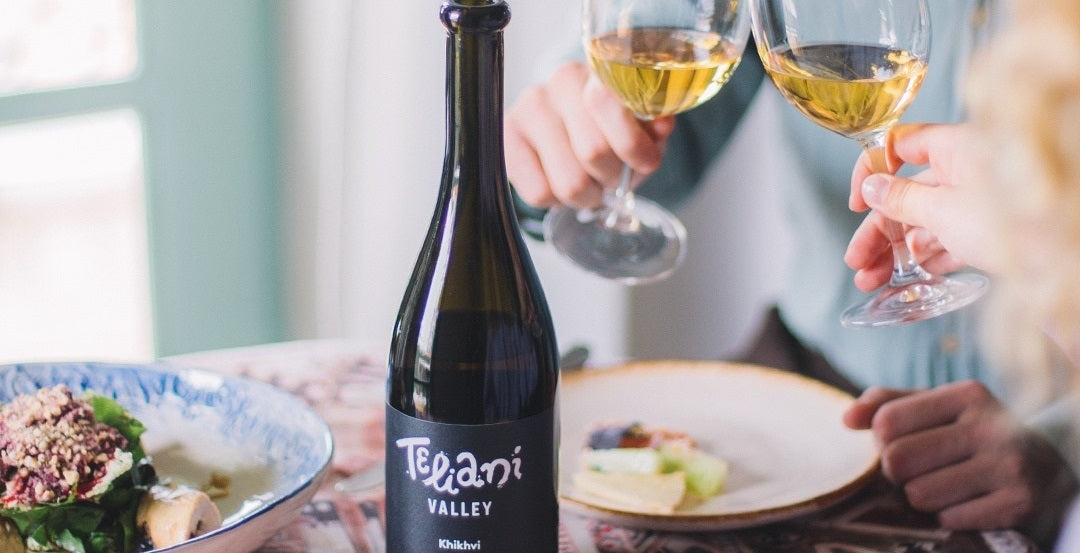Georgia has one of the oldest winemaking histories in the world with evidence of wine being discovered by archeologists from up to 8000 years ago. As a country situated at a crossroads between Europe, Asia and the Middle East, it provided wine and vines to the first cities of Babylon, and many of the vines cultivated in Europe and Asia today are said to have Georgian origins. Even the western words for wine are likely derived from the Georgian word ghvino.
Wine making techniques developed at this time are surprisingly still in use today, the most traditional technique involves an egg-shaped clay vessels called qvevri. They are big, holding 1000 or more litres and they are buried underground to keep temperatures constant during fermentation and aging. Winemakers would ferment the juice and skins together and this skin contact turns what would otherwise be white wines into amber wines with tannins.
Skin contact white wine - or orange wine - is having a moment in the spotlight thanks in part to the growing interest and popularity of the natural wine scene. It has allowed winemakers to reach a new audience for juice that would otherwise seem too unusual for importers and retailers to take a chance on.
While qvervi represents a link to the past, the majority of the wine Georgia produces is made using modern techniques and there is huge variety of indigenous grapes to discover.
525 grape varieties are known, three quarters of which are white such as varieties Rkatsiteli, Kakhuri Mtsvane, Khikhvi and Kisi. Red grapes make up the other 25%
These are grown over across four key regions: Kakheti, Imereti, Kartli and Racha-Lechkhumi with Kakheti producing the largest amount of grapes by far. It's also the home of our featured producer, Teliani Valley.
Teliani Valley was established in the 1990s by a group of enthusiastic young winemakers looking to continue the history of winemaking in the village that has existed since the 1800s. The quality of the vineyards and the teams winemaking ability took them from their humble beginnings in a ramshackle converted car workshop to become one of the biggest producers in Georgia.
One of the original founders of the company, Gogi Dakishvili, still oversees the production of the Glekhuri Qvevri wines, and to complement the tradition they have assembled a team of innovative young winemakers at a more modern facility called Winery 97. Here they have the time, equipment, fruit and support they need to create really exciting modern style wines.
In addition to their smaller scale premium wine projects, much of Teliani's production is basic wine, usually sold to Ukraine and Russia - however the current invasion of Ukraine by Russia has effectively wiped out this market and left the winery with a very big logistical headache.
We have stocked their wine for over a couple of years now and have decided to support the winery by promoting two of our favourites from their range at fantastic prices.

Teliani Valley, Winery 97 Khikhvi 2020
The wine is made using old Kakhetian traditional winemaking method with skin contact. Fermentation on skins takes place for 7-10 days, once the fermentation is finished the grape skin remains with the wine for 6 months which gives the wine its colour and a little grippy tannin.
On the nose you immediately get rich dried apricot and orange fruit and nutty flavours. It feels smooth and round on the palate but there there is enough acidity to deliver a long, dry refreshing finish. Don't chill it, you'll just bring the tannins forward at the expense of the lovely flavours - serve cool, not cold!
Traditionally a wine like this would be enjoyed with fatty and nutritious foods ranging from sheep's cheese with tarragon or dambal khacho (very mature cottage cheese) to khashlama (boiled meat). It can also work well with spicy or peppery dishes, like shila pilaf (rice with meat or mushrooms), with a chakapuli of lamb cooked with tarragon or with chicken.
Teliani Valley, Winery 97 Saperavi 2020
Made from another indigenous grape variety – Saperavi, which is also hand harvested to ensure quality. Saperavi can be a versatile grape and depending on how it is made it can resemble Malbec, Cabernet Franc and even Gamay. In this case we are firmly in Malbec territory – a strikingly deep purple colour, bright and juicy with fresh crunchy dark berry flavours and perfectly balanced acidity.
The wine pairs well with spicy sausage stew, a juicy burger and barbecued meats. Saperavi is also good with pork cooked on skewers, expensive hard cheeses, liver kaurma (liver cooked in a pot) or with "oyster" mushrooms.
These are great quality wines with loads of character and we urge you to give them a try.






Leave a comment (all fields required)